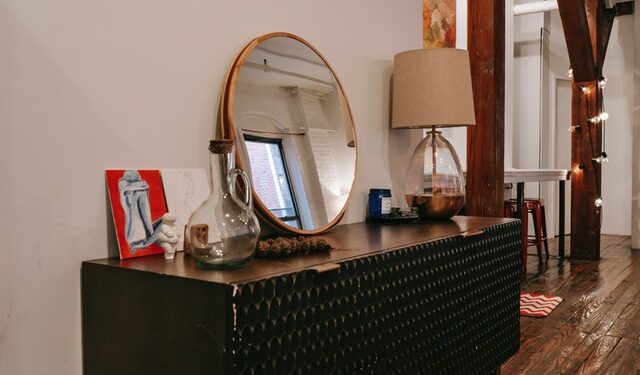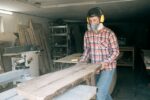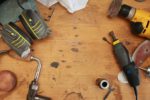How does petrified wood form

Petrified wood is a type of fossil in which the original organic material has been replaced by minerals, most often a form of quartz. The petrification process takes place when dissolved minerals fill the spaces between the cells of the wood and gradually replace the cell walls. While petrified wood can be found all over the world, it is especially common in the southwestern United States.
Petrified wood forms when a tree falls into an environment where there is little or no oxygen, such as a swamp or bog. The lack of oxygen prevents the wood from decomposing. Over time, water percolates through the wood, carrying dissolved minerals. These minerals gradually replace the organic material in the wood, a process known as permineralization.
The most common minerals found in petrified wood are quartz, calcite, and pyrite. However, a wide range of other minerals can be found in petrified wood, depending on the location where it forms. For example, petrified wood from Arizona often contains agate, while petrified wood from Wyoming often contains jasper.
Petrified wood is typically found as logs or stumps, although other parts of trees, such as branches and leaves, can also be petrified. The logs are usually the best-preserved specimens, as they are less likely to be broken up by geological processes.
The petrification process can take place over a wide range of time scales, from a few years to several million years. The exact timing depends on the conditions where the wood is buried. For example, wood that is buried in an environment with high temperatures and pressures will petrify more quickly than wood that is buried in a cooler environment.
Petrified wood is a valuable resource for scientists who study Earth’s history. The fossils can provide information about the environment and climate of the region where they formed, as well as the types of plants that were present at that time. In some cases, petrified wood can even be used to date other fossils found in the same area.
Petrified wood is also a popular gemstone and is used in a wide range of jewelry and other decorative items. The wood can be carved into a variety of shapes and polished to produce a glossy finish. It is also common to use slices of petrified wood as tabletops or countertops.
How to care for a piece of petrified wood
If you’ve ever stumbled across a piece of petrified wood, you know just how cool it can be. This fascinating fossil is formed when the original organic material in a tree has been replaced by minerals, most often quartz. While petrified wood can be found all over the world, it is especially common in the southwestern United States.
Petrified wood is a valuable resource for scientists who study Earth’s history. The fossils can provide information about the environment and climate of the region where they formed, as well as the types of plants that were present at that time. In some cases, petrified wood can even be used to date other fossils found in the same area.
Petrified wood is also a popular gemstone and is used in a wide range of jewelry and other decorative items. The wood can be carved into a variety of shapes and polished to produce a glossy finish. It is also common to use slices of petrified wood as tabletops or countertops.
If you’re lucky enough to have a piece of petrified wood, you’ll want to take care of it so that you can enjoy it for years to come. Here are a few tips on how to care for your petrified wood:
– Avoid exposing your petrified wood to direct sunlight or extreme temperatures, as this can cause the fossil to crack or break.
– Keep your petrified wood in a cool, dry place.
– If you’re displaying your petrified wood, make sure it is supported so that it doesn’t break under its own weight.
– Clean your petrified wood with a soft, dry cloth. Avoid using harsh chemicals or abrasive cleaners, as these can damage the fossil.
By following these simple tips, you can help ensure that your petrified wood will be around for many years to come.
The history of petrified wood
Petrified wood is a valuable resource for scientists who study Earth’s history. The fossils can provide information about the environment and climate of the region where they formed, as well as the types of plants that were present at that time. In some cases, petrified wood can even be used to date other fossils found in the same area.
Petrified wood is a type of fossilized wood that has been turned into stone through the process of permineralization. This occurs when the organic matter in wood is replaced by minerals, most often quartz. Petrified wood can be found all over the world, but it is especially common in the southwestern United States.
The science behind petrified wood
Petrified wood is a valuable resource for scientists because it can provide information about the environment and climate of the region where it formed, as well as the types of plants that were present at that time. In some cases, petrified wood can even be used to date other fossils found in the same area. Petrified wood is also a popular gemstone and is used in a wide range of jewelry and other decorative items. The wood can be carved into a variety of shapes and polished to produce a glossy finish. It is also common to use slices of petrified wood as tabletops or countertops.
If you’ve ever found a piece of petrified wood, you may be wondering how it forms. Petrified wood is created through a process called permineralization, which occurs when the organic matter in wood is replaced by minerals, most often quartz. This can happen over the course of millions of years as water seeps into the wood and deposits minerals in its place. Once the process is complete, the wood is transformed into stone and becomes a fossil.
Petrified wood is found all over the world, but it is especially common in the southwestern United States. This is because the region has a large number of petrified forests, which are areas where large amounts of petrified wood can be found. Petrified forests are typically found in desert regions, as this is where the conditions are most favorable for permineralization to occur.
If you’re lucky enough to have a piece of petrified wood, you’ll want to take care of it so that you can enjoy it for years to come. Here are a few tips on how to care for your petrified wood:
– Avoid exposing your petrified wood to direct sunlight or extreme temperatures, as this can cause the fossil to crack or break.
– Keep your petrified wood in a cool, dry place.
– If you’re displaying your petrified wood, make sure it is supported so that it doesn’t break under its own weight.
– Clean your petrified wood with a soft, dry cloth. Avoid using harsh chemicals or abrasive cleaners, as these can damage the fossil.
By following these simple tips, you can help ensure that your petrified wood will be around for many years to come.
How does petrified wood form
Petrified wood is a valuable resource for scientists because it can provide information about the environment and climate of the region where it formed, as well as the types of plants that were present at that time. In some cases, petrified wood can even be used to date other fossils found in the same area. Petrified wood is also a popular gemstone and is used in a wide range of jewelry and other decorative items. The wood can be carved into a variety of shapes and polished to produce a glossy finish. It is also common to use slices of petrified wood as tabletops or countertops.
Petrified wood forms when the organic matter in wood is replaced by minerals, most often quartz. This can happen over the course of millions of years as water seeps into the wood and deposits minerals in its place. Once the process is complete, the wood is transformed into stone and becomes a fossil.
Petrified wood is found all over the world, but it is especially common in the southwestern United States. This is because the region has a large number of petrified forests, which are areas where large amounts of petrified wood can be found. Petrified forests are typically found in desert regions, as this is where the conditions are most favorable for permineralization to occur.
If you’re lucky enough to have a piece of petrified wood, you’ll want to take care of it so that you can enjoy it for years to come.






